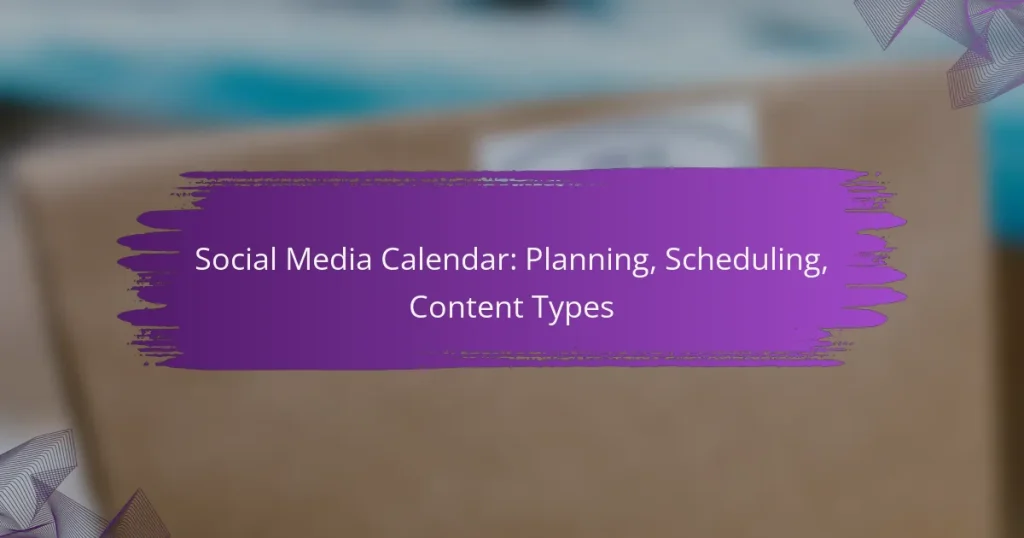A social media calendar is an essential tool for planning and scheduling content, ensuring consistent engagement with your audience. By organizing your posts strategically, you can align your content with your marketing goals and audience preferences. Incorporating a diverse range of content types will further enhance engagement and effectiveness in your social media strategy.
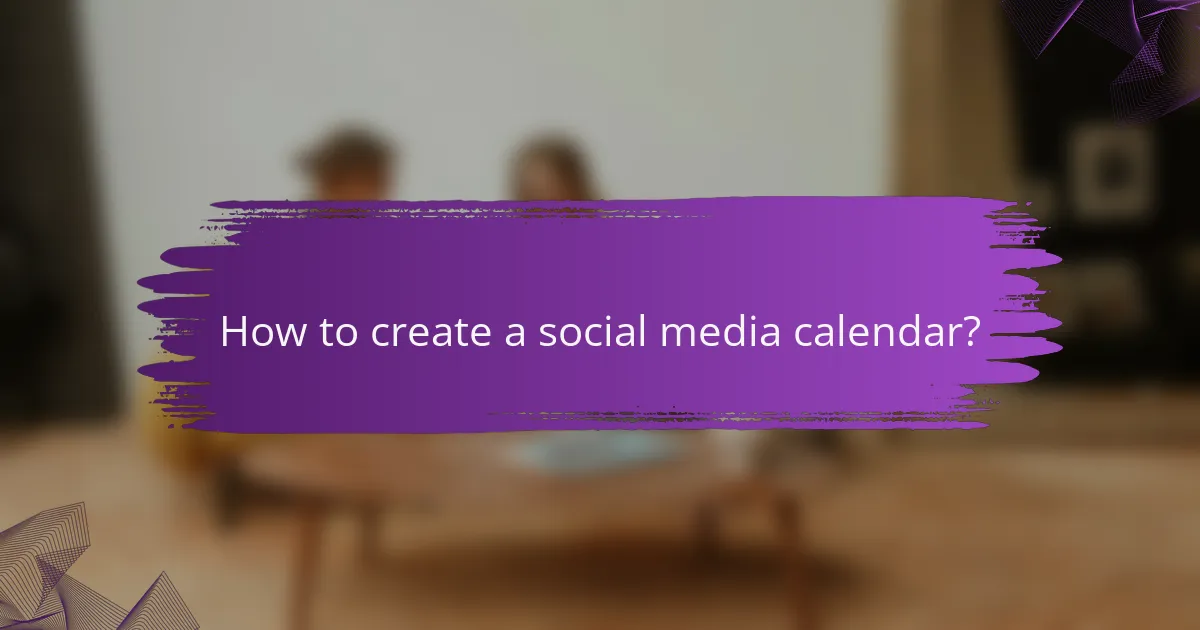
How to create a social media calendar?
Creating a social media calendar involves planning and scheduling your content to ensure consistent engagement with your audience. This tool helps streamline your posting strategy, allowing you to align your content with your goals and audience preferences.
Define your goals
Start by identifying what you want to achieve with your social media presence. Common goals include increasing brand awareness, driving website traffic, or boosting sales. Clearly defined objectives will guide your content choices and posting strategies.
Consider using the SMART criteria—Specific, Measurable, Achievable, Relevant, and Time-bound—to refine your goals. For instance, aiming to increase followers by 20% in six months is a measurable and time-bound goal.
Choose a scheduling tool
Selecting the right scheduling tool is crucial for efficient management of your social media calendar. Popular options include Hootsuite, Buffer, and Sprout Social, each offering unique features for scheduling, analytics, and team collaboration.
When choosing a tool, consider factors such as ease of use, integration capabilities with your existing platforms, and pricing. Many tools offer free trials, allowing you to test their functionality before committing.
Map out content types
Decide on the types of content you want to share, such as blog posts, videos, infographics, or user-generated content. A diverse mix can keep your audience engaged and cater to different preferences.
For example, you might allocate 40% of your posts to educational content, 30% to promotional material, and 30% to community engagement. This balance can help maintain interest and encourage interaction.
Set posting frequency
Establish how often you will post on each platform to maintain a consistent presence. Posting frequency can vary by platform; for instance, daily posts may work well on Twitter, while 2-3 posts per week might be sufficient for Facebook or Instagram.
Monitor engagement metrics to find the optimal posting frequency for your audience. Adjust your schedule based on performance, ensuring you don’t overwhelm your followers while keeping your brand top-of-mind.
Review and adjust regularly
Regularly reviewing your social media calendar is essential for staying relevant and effective. Analyze performance metrics, such as engagement rates and follower growth, to assess what’s working and what isn’t.
Be prepared to adjust your goals, content types, and posting frequency based on these insights. A flexible approach allows you to respond to changing trends and audience preferences, ensuring your strategy remains effective over time.
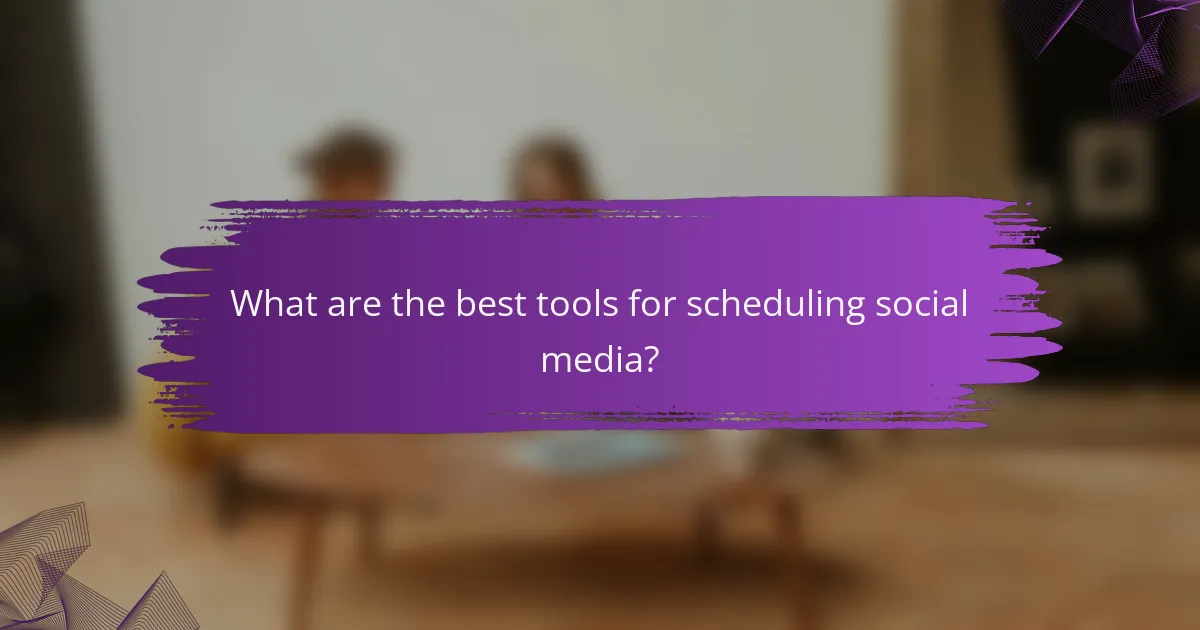
What are the best tools for scheduling social media?
The best tools for scheduling social media streamline the process of planning and posting content across various platforms. They help users manage multiple accounts, analyze performance, and optimize posting times for maximum engagement.
Hootsuite
Hootsuite is a comprehensive social media management tool that allows users to schedule posts, monitor engagement, and analyze performance across various platforms. It supports a wide range of networks, including Facebook, Twitter, Instagram, and LinkedIn, making it versatile for businesses of all sizes.
One key feature of Hootsuite is its ability to create custom reports, which can help you understand your audience better and refine your strategy. Pricing plans vary, with options for individuals and larger teams, typically starting from around $19 per month.
Buffer
Buffer is known for its user-friendly interface and simplicity, making it a great choice for small businesses and individuals. It allows users to schedule posts in advance and offers a browser extension for easy sharing of content from anywhere on the web.
Buffer’s analytics feature provides insights into post performance, helping users identify the best times to post. Pricing starts at about $15 per month, with different tiers based on the number of accounts and features needed.
Sprout Social
Sprout Social is a robust platform that combines scheduling, monitoring, and analytics in one place. It is particularly well-suited for teams, offering collaboration tools that allow multiple users to manage social media accounts efficiently.
With Sprout Social, users can schedule posts, track engagement metrics, and generate detailed reports. The pricing is higher than some competitors, starting around $99 per month, reflecting its comprehensive features and team-oriented capabilities.
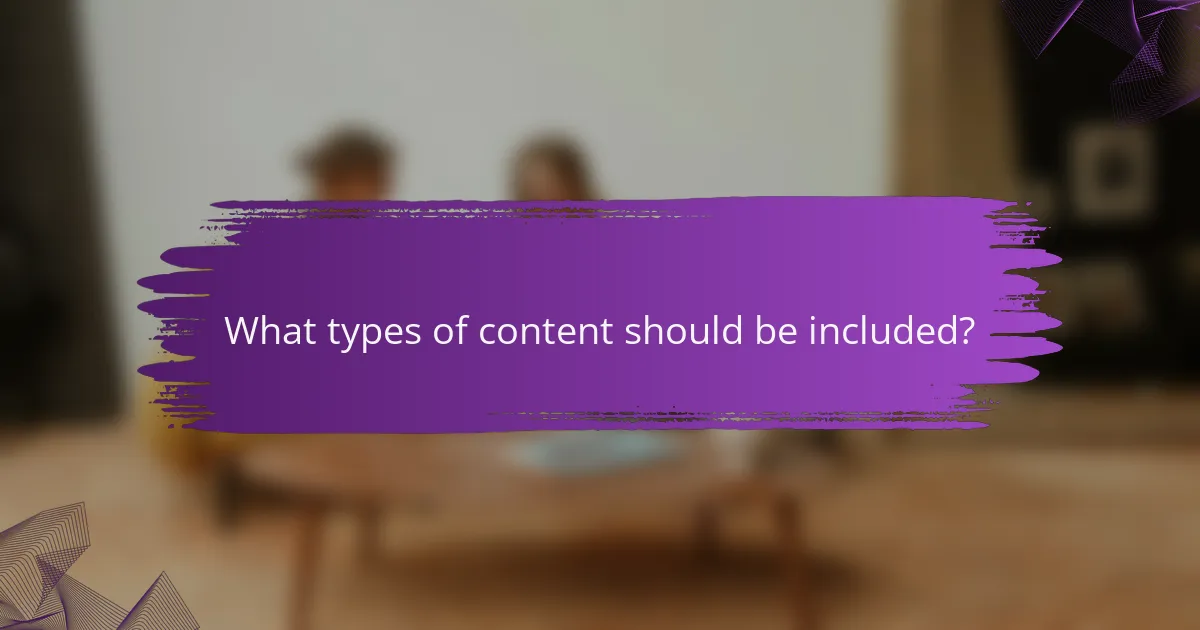
What types of content should be included?
Including a variety of content types in your social media calendar is essential for engaging your audience and achieving your marketing goals. Focus on promotional posts, engagement-driven content, educational resources, and user-generated content to create a balanced and effective strategy.
Promotional posts
Promotional posts are designed to showcase your products or services and drive sales. These can include special offers, discounts, or announcements about new launches. Aim to keep these posts around 20-30% of your overall content to avoid overwhelming your audience with sales pitches.
Consider using eye-catching visuals and clear calls-to-action to enhance the effectiveness of promotional posts. For example, a limited-time discount can create urgency and encourage immediate engagement.
Engagement-driven content
Engagement-driven content aims to foster interaction and build community among your followers. This can include polls, questions, contests, or interactive stories. Such content encourages users to comment, share, and participate, which can significantly increase your reach.
To maximize engagement, tailor your content to your audience’s interests and preferences. For instance, asking for opinions on a trending topic can spark discussions and keep your audience invested in your brand.
Educational resources
Educational resources provide value to your audience by sharing knowledge or insights related to your industry. This can include how-to guides, infographics, or informative videos. Aim to position your brand as an authority by offering content that addresses common questions or challenges faced by your audience.
When creating educational content, ensure it is easy to digest and visually appealing. For example, a short video tutorial can effectively convey complex information in a straightforward manner.
User-generated content
User-generated content (UGC) involves sharing content created by your customers or followers. This can include testimonials, reviews, or photos of customers using your products. UGC not only builds trust but also encourages community involvement and loyalty.
To effectively incorporate UGC, create a branded hashtag and encourage your audience to share their experiences. Highlighting this content on your platforms can enhance authenticity and foster a sense of belonging among your followers.
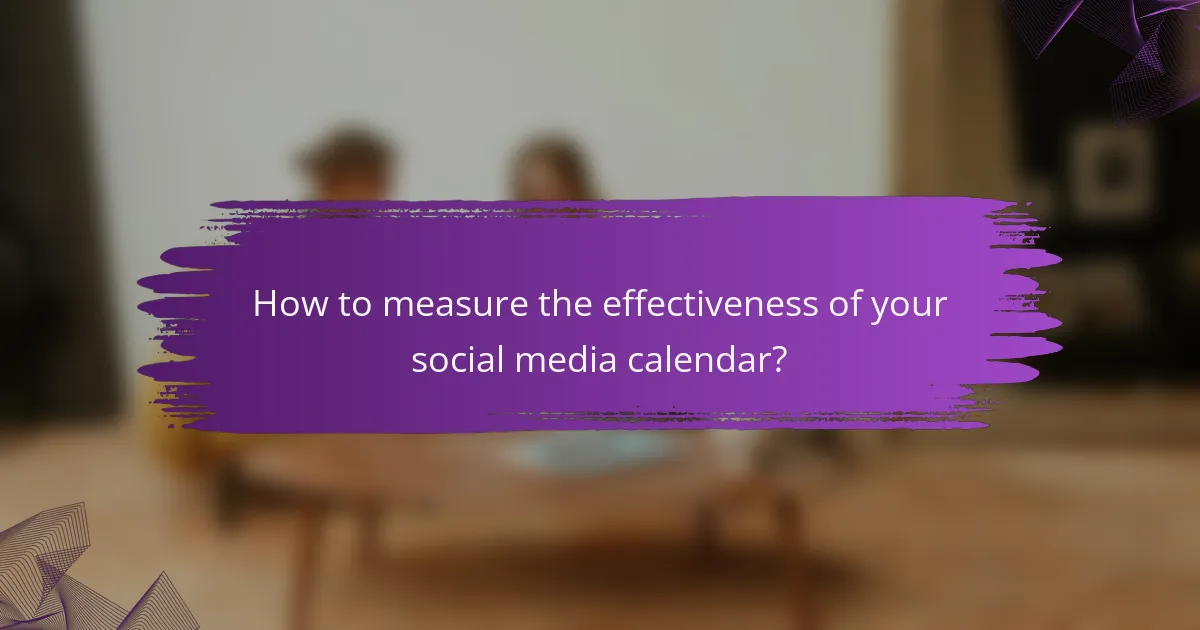
How to measure the effectiveness of your social media calendar?
Measuring the effectiveness of your social media calendar involves assessing key performance indicators that reflect engagement, audience growth, and content performance. By analyzing these metrics, you can refine your strategy to enhance your social media presence.
Track engagement metrics
Engagement metrics include likes, shares, comments, and overall interaction rates with your posts. Monitoring these figures helps you understand what content resonates with your audience. Aim for a consistent engagement rate, typically between 1% to 5% of your total followers, depending on your industry.
Utilize analytics tools provided by platforms like Facebook Insights or Instagram Analytics to track these metrics over time. Regularly review your posts to identify trends in engagement, allowing you to adjust your content strategy accordingly.
Analyze audience growth
Audience growth is a critical metric that reflects the effectiveness of your social media calendar. Track the number of new followers gained over specific periods, such as weekly or monthly. A steady growth rate of around 5% to 10% per month is generally considered healthy.
Evaluate the sources of your new followers, whether through organic reach, paid ads, or referrals. Understanding where your audience comes from can help you allocate resources effectively and target your marketing efforts to maximize growth.
Evaluate content performance
Content performance evaluation involves analyzing how different types of posts perform in terms of reach and engagement. Categorize your content into formats such as images, videos, or articles, and compare their effectiveness. For instance, video content often achieves higher engagement rates than static images.
Use A/B testing to experiment with different headlines, posting times, and formats to see what works best. Regularly review your top-performing content to replicate successful strategies and eliminate underperforming posts from your calendar.
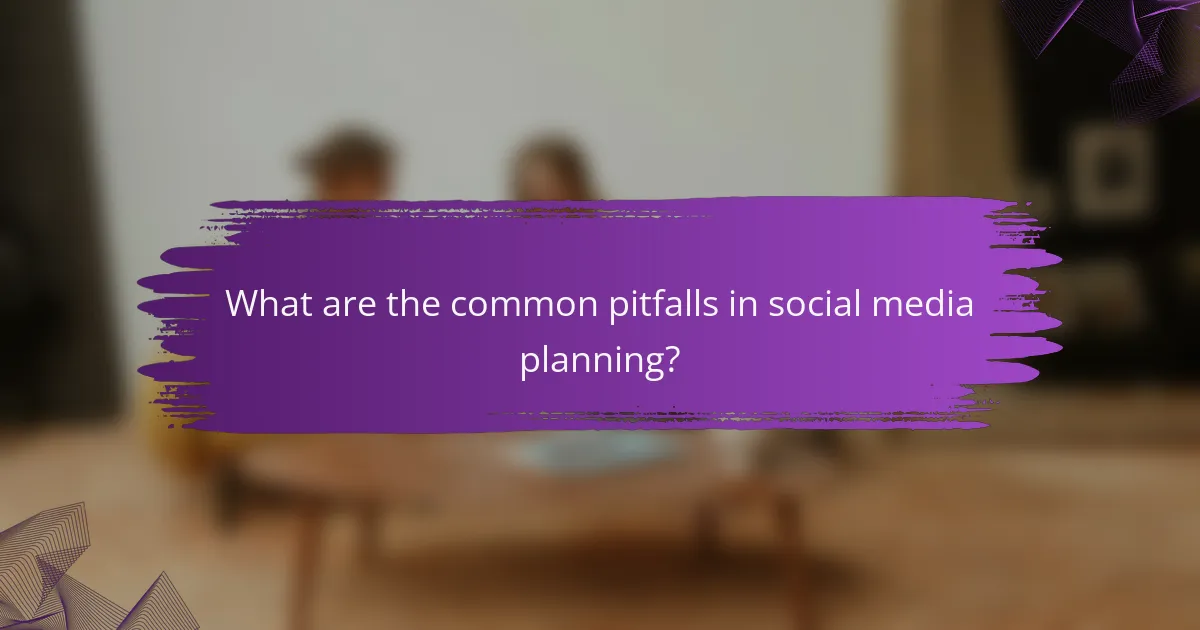
What are the common pitfalls in social media planning?
Common pitfalls in social media planning include lack of clear goals, inconsistent posting, and neglecting audience engagement. These missteps can lead to ineffective strategies and wasted resources.
Neglecting Audience Research
Failing to understand your audience can severely impact your social media effectiveness. Without proper research, you may create content that doesn’t resonate with your followers, leading to low engagement rates.
To avoid this pitfall, invest time in analyzing your target demographic. Use tools like surveys or social media analytics to gather insights on preferences, behaviors, and interests.
Inconsistent Posting Schedule
Inconsistency in posting can confuse your audience and diminish your brand’s visibility. A sporadic posting schedule may result in followers forgetting about your brand or losing interest.
Establish a content calendar to maintain a regular posting rhythm. Aim for a frequency that suits your audience, such as several times a week, and stick to it to build anticipation and engagement.
Ignoring Analytics and Feedback
Overlooking analytics and audience feedback can prevent you from optimizing your social media strategy. Ignoring performance metrics means missing opportunities to refine your approach based on what works.
Regularly review your analytics to identify high-performing content and adjust your strategy accordingly. Encourage feedback through polls or comments to understand audience preferences better.
Overemphasis on Promotion
Focusing too much on promotional content can alienate your audience. If followers feel they are constantly being sold to, they may disengage or unfollow your accounts.
Balance promotional posts with valuable content that educates or entertains your audience. Aim for a mix of 70% engaging content and 30% promotional material to maintain interest and loyalty.
